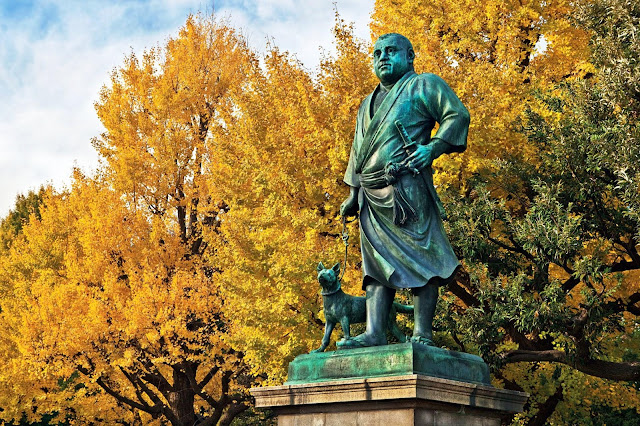 |
| Saigo Takamori |
The Battle of Shiroyama took place on 24 September 1877 on the idyllic summit of a hill called Shiroyama in Kagoshima, Japan. It was the final battle of the Satsuma Rebellion and the last ever occurrence of armed resistance by the samurai class against the new imperial government.
 |
| Battle of Shiroyama |
To help support and employ these ex-samurai, in 1874 Saigo established a private academy in Kagoshima. Soon 132 branches were established all over the prefecture. The “training” provided was not purely academic: although the Chinese classics were taught, all students were required to take part in weapons training and instruction in tactics. The traditions of bushido were emphasized. Saigo also started an artillery school. The schools resembled paramilitary political organizations more than anything
 |
| Kagoshima Prefecture |
The Siege at Kumamoto Castle from February to early April 1877 was the first major engagement and turning point of the seven-month civil war with the samurai rebels sustaining significant casualties and as a result Saigo's forces could no longer threaten imperial power outside the island of Kyushu. From mid-April to late September 1877 the course of the rebellion was essentially a series of concentrations and dispersals of Saigo's men. They were defeated in subsequent major battles at Hitoyoshi, Nobeoka and Miyakonoja, and were eventually cornered on home ground in Kagoshima city. By 2 September the Satsuma army had dwindled to less than 300 combatants occupying the picturesque hill in Kagoshima called Shiroyama. Within six days the Imperial Army surrounded the rebels with five brigades, and began cautious and lengthy preparations for a final assault supported by artillery and naval batteries.
Imperial Army troops under the command of General Yamagata Aritomo and marines under the command of Admiral Kawamura Sumiyoshi outnumbered Saigo 60 to 1. However, Yamagata was determined to leave nothing to chance. The imperial troops spent several days constructing an elaborate system of ditches, walls and obstacles to prevent the samurai breaking out and escaping. The five government warships in Kagoshima harbour added their firepower to Yamagata's artillery, and began to systematically reduce the rebel hillside positions.
After Saigo rejected a letter dated September 1 from Yamagata asking him to surrender, Yamagata ordered a full frontal infantry assault on September 24, 1877. By 6 a.m., only 40 rebels were still alive and Saigo was severely wounded. The exact manner of his death is a matter of fierce debate. The accounts of his subordinates claim either that he up righted himself and committed seppuku after his injury, or that he requested that a comrade assist his suicide. In debate, some scholars have suggested that neither is the case, and that Saigo may have gone into shock following his wound, losing his ability to speak. Several comrades upon seeing him in this state, would have severed his head, assisting him in the warrior's suicide they knew he would have wished. Later, they would have said that he committed seppuku in order to preserve his status as a true samurai. It is not clear what was done with Saigo's head immediately after his death. Some legends say Saigo's manservant hid the head, and it was later found by a government soldier and was reunited with Saigo's body, which was laid next to that of his deputies Kirino and Murata. This was witnessed by the American sea captain John Hubbard. A myth persists that the head was never found.
 |
| Shiroyama today |
Financially, crushing the Satsuma Rebellion cost the government greatly, forcing Japanese currency off the gold standard and causing the government to print paper money. The rebellion was also effectively the end of the samurai class, as the new Imperial Japanese Army built of conscripts without regard to social class had proven itself in battle.
Many legends sprang up concerning Saigo, many of which denied his death. Many people in Japan expected him to return from British India or Qing Dynasty China or to sail back with Tsesarevich Alexander of Russia to overthrow injustice. It was even recorded that his image appeared in a comet near the close of the 19th century, apparently an ill omen to his enemies. Unable to overcome the affection that the people had for this epitome of traditional samurai virtues, the Meiji Era government pardoned him posthumously on February 22, 1889.
